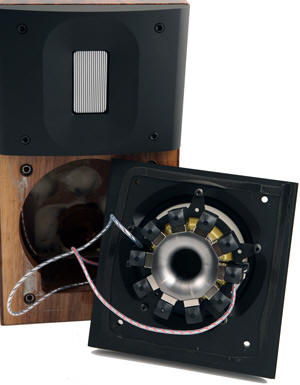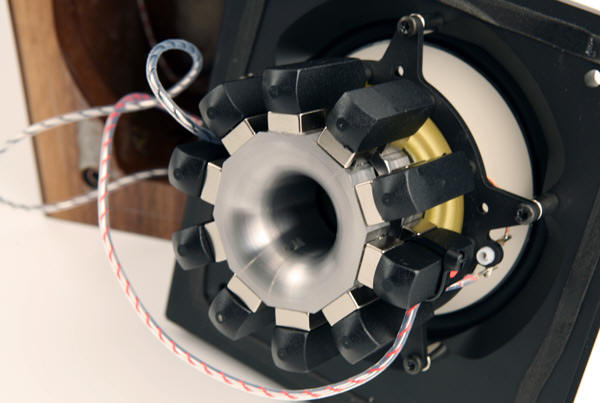As important as material is to a driver, no driver can be any better than it’s magnet motor allows it to be. The truth is, the magnet systems on most speakers systems have gotten worse, not better, over the last 50 years. Just think about the premium you pay for good rare-earth magnets in speakers. Raidho’s design team felt that neodymium magnets opened a new age of opportunity for making driver motors. Their system consisted of two rows of neodymium magnets placed in a push-pull configuration. They claimed this would create a very controllable flux in the magnet gap, as well as creating a very open structure where they could control the way the magnets affected the rest of the driver. They felt this patented magnet system would allow air to move more freely, with more control and far less compression than any other driver on the market.
Like all the mini-monitors I have had in for review, the Ayras C1s were stand mounted, and like the Teresonics, they came with accompanied stands designed and built to bring out their best sound. Don’t you wish all mini-monitors would come with such stands?
Starting with the stands, the Ayras’ design was all about resonance control. The stands were made of MDF, plywood, and aluminum. I would think this, in itself, really cut down on resonance. They were impeccably braced and coupled to the speaker. Still, compared to most high end speakers’ stands, they were very light weight and let the speakers move rather easily. In fact, they moved so easily that it made me check to see if I had done everything correctly. Raidho says that this allows for the speaker to be much more dynamic compared to mass loading the stands. This was exactly my experience with Audio Note E speakers and the differences between the mass loaded stands from Audio Note and the Sistrum stands. In this comparison, the speakers seemed more efficient with the Sistrum stands compared to Audio Note’s mass loaded stands.
In Russell Baker’s book, Growing Up, he said that nothing lied like a thermometer. It seemed his grandmother had one of the front porch, but he said it was just for looks. The real thermometer was his uncle who would go out to feed the animals in the morning and when he came back he would tell the family whether it was tolerable, terribly cold, or terribly cold with a right smart of wind. Baker said that his uncle was far more accurate than the thermometer.
Now, the reason I share this little tidbit from Baker’s book is that it illustrates my experience with speaker specifications, and the Ayra C1s are a prime example. The specs suggest these speakers are more efficient than the B&W 805S speakers, but they surely do not play as loud with the volume set at the same place on the Plinius 9200 integrated amplifier or the Oracle SI1000. The Ayra required the amps to be turned up to what I felt was a considerable amount in comparison to the 805S.
Set Up And Placement
These were not speakers I could just plop down in the same place as my reference speakers and hook up to my 10-watt Wavac EC300B. But, I had some great high power amps in for review, so this was no problem. These little Danish wonders, combined with the Oracle integrated, produced a prodigious soundstage with incredible width and depth. The combination had speed and detail that was truly amazing. Well, I’ll get into more about that later in the review. The truly musical and powerful Plinius alternated with the Oracle.
Of my three favorite speakers, none worked best with typical audiophile speaker placement, i.e. well out from the front and side walls. The Audio Note E speakers were designed for corner placement, and both the Ikonoklast Model 3HOs and the Teresonic Ingenium MK2 sounded best in my room nearer the rear and side walls than most modern speakers would be placed. Brian recommended the Ayras be placed well out into the room and a good 8 feet apart. He said to toe them in sharply towards your shoulders while sitting in the sweet-spot. This was exactly where they sounded best upstairs.
Downstairs in the reference system, I was able to pull them even further out into the room, but found them to sound their best about seven feet apart.
The Ayras were not difficult speakers to set up, but it was important to get them away from the walls, toe them in correctly, and this is important: Do not put a tall rack or a television in between them. You don’t need to be afraid to pull them way out from the walls. I know with speakers this size you will be worried about the bass if you pull them out like this, but don’t worry. They had plenty of bass and by the way, really good bass. Placed correctly, the Ayra C1s produced a sound that would make you look around the room for where the speakers were located, but to do this they need plenty of uncluttered space around and behind them.
- ← Previous page
- (Page 2 of 4)
- Next page →



Why don’t you have prices in any of your reviews?
Lindy,
Thank you for your email and readership. We are backfilling the MSRP information into Reviews as we speak because of the Jan 1, 2013 relaunch. Thank you for your patience.
I had B&W 805 and 805s, before them I had Gamut Phi3 (small series), and Gamt Phi3 use to play better than B&W 805s, now I have Gamut M’Inent M3 and trust me, I have sold my B&W 805s because they are really not in the same class, and to notice that I’ve owned Gamut L3 as well, still better than B&W…Sorry mate but I have to disappoint you, we don’t like same things in music, which is why everyone else desides better himself, at the spot…live listening.